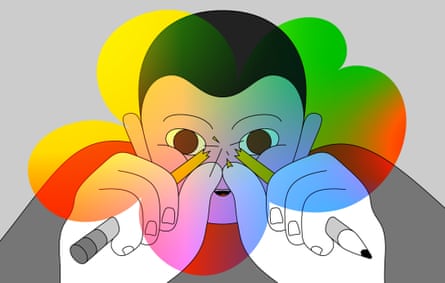
Creating art isn’t just a pastime, it is a way of living. But how can you nurture a more artistic existence? Artists share their advice on how to be more creative.
It doesn’t matter if you can’t draw
Helen Cammock was one of the winners of the Turner prize in 2019 and says she didn’t have artistic tendencies as a child, despite being the daughter of an art teacher. “Just because you can’t draw something in a representative, representational way, it doesn’t mean that you’re not creative,” she says. Cammock, who lives in north Wales, works across “film, photography, print, performance, writing and text”. She is hopeful that art lessons at school have changed to be less focused on representational drawing and painting.
It’s never too late to create
Cammock was 35 when she began studying art – after a 10-year career as a social worker. She says it is important to keep challenging ourselves by trying new things. “The older we get as adults, the less we feel comfortable taking risks. If we think about the kinds of things we did when we were children and tested out when we were teenagers, somehow it gets squeezed out of you and risk-taking is not a space that you can inhabit. There is something about enabling yourself to try things and not have expectations about what you will produce.” Cammock is now having trumpet lessons: “I will never be a wonderful trumpet player but it is important to me that I open myself to new things all the way through my life.” Anne Ryan, an Irish artist who works in paint, ceramics and sculpture, has taken up tap dancing for a similar reason. “I’m crap at it but I come out glowing and feeling like I have spread a little bit of love,” she says. That energy feeds into her art.
Find your space
Or your “container”, as Cammock calls it. “A container for me is walking. It is a way of being in a particular space, emotionally, psychologically and intellectually. And that could be in the mountains, or walking across London to get to a meeting instead of getting on the tube. I drive long distances in silence, and those are some of the most fruitful moments, this container in the car, where nobody else can see me, nobody else is with me. It could be a desk that you have in a busy house, or it could be a window, or it could be lying in the bath. I think people do it in gardens, if they have them, or on balconies. It is about affording yourself time and space where you are somehow in your own head.”
Get moving
A fellow walker is east London-based Babak Ganjei, who travels by foot as much as possible in search of inspiration for his text-based paintings. “All the thinking happens while moving,” he says. “I actually find it really hard to sit still. When I sit and try to come up with things, I get bogged down in trying to work out if I’m actually thinking.” Ryan says she is constantly moving in the studio: “I am very physical when I make; it’s like music goes through my body.” Alberta Whittle, a Barbadian-Scottish artist, says that when she is lacking in inspiration she dances: “Sometimes, I really need to move my body and shake things up, so having a solo dance party can really help.”
Understand the importance of looking
“The only thing you really learn at art school is looking,” says Ganjei, who studied at Central Saint Martins in London. “Being creative is all about looking at the world and taking in information in a different way,” says Ryan. “Whether you’re a poet, or a painter, or a writer, to make work you have to step outside yourself.” The portrait artist Stuart Pearson Wright, who lives in Suffolk, says: “It is about really taking the time to stop and observe things. And whether that is observing things in a visual world, listening to things or spending time in nature, it is about finding sources of inspiration.”
Keep an ideas notebook or sketchbook
Cammock has an ideas book on the go all the time, and when she doesn’t have access to it, such as at night, she uses her phone to make notes. Whittle also jots things down after she’s gone to bed: “I will wake up with ideas or fragments of dreams related to whatever I’m working on and I need to get them out of my head on to the page. I’ve got a terrible memory, so my notebooks or scrap paper come in handy for writing things down in the night or from dreams.” Pearson Wright says: “I feel most comfortable taking a sketchbook to the pub. Then if I don’t know what to talk about, I can just draw people.” Mental notes are valid too. “I don’t make as many notes as I should,” says Ganjei. “It’s almost like I just trust the ones that stay … My brain is the thing that weeds them out.”
Don’t put pressure on yourself to produce
Ryan teaches foundation and degree-level art and is about to start a new sculpture course. One of the fundamentals she tells her students is: “It’s not about going into the studio to make a painting, because then you never do. But it’s going in to read a book or play with things. Don’t try to make something or it just won’t happen.” Cammock says: “What I’ve learned is that the best thing for me is to take the pressure off and do something else, and trust that it will come – it always does.”
Take inspiration from others – but know when to look away
“It is always lovely to talk to artists, go to galleries and be part of that community,” says Ryan, “but when I’m making, there is a point where you’re looking at loads and there’s a point when you have to stop and look at yourself.”
Learn about the history of art
“The thing with artists is they absorb other artists,” says Ryan. “So if you are looking back to, say, Cézanne and El Greco, you become part of that timeline and it is part of your story. I tell students to look back and create a family, whether it’s something from the 1700s or whenever. It narrows your world in a good way. You start seeing cultures and ideas through the ages very differently, because you start placing yourself there.” Your style may be reminiscent of what has come before it. For a while Ganjei made work with the text “Not David Shrigley”. “It is quite hard to know when you’ve been influenced by something or when it’s your original idea,” Ganjei says, “because if you’ve found something that simple, it almost always existed.”
Consume other culture too
Ganjei loves listening to comedy podcasts while he pounds the pavements; at the moment Conan O’Brien is a favourite. He also sees a lot of standup. Ryan goes to gigs, from girl punk bands such as Panic Shack to folk reminiscent of the music she grew up with. Whittle appreciates it when “family and friends send me links to articles and posts, which can really shift how I’m feeling in myself and in my work. I love a good meme!”
Use mistakes to your advantage
“Trust yourself,” says Whittle. “So much time is wasted worrying about making something that is perfect. Perfection is overrated and the mistakes are often far more interesting.” Ganjei cringes reminiscing about his disastrous A-level art painting exam which took him from an A to a C. “But I’m realising, as I’ve got older, I can use that painting in something else – it’s a funny story. The painting is awful but there is something in it somewhere else. Your mistakes could be positive in a different form.”
Learn to love your own company
“One of the essential things for creating is you have to love to be on your own because we spend a lot of time on our own,” says Ryan.
Work out what time of day you get into the zone
“I’m a morning person,” says Whittle, “but I’m a bit obsessive, so it can be really hard to pull myself away from whatever I’m working on and I can end up working until the wee hours.” Ryan says she can be in the studio all day, but it isn’t until the evening that she really clicks into gear: “There’s a buildup to get to that point in the zone. For me, 5-5.30pm is the turning point.”
Create close to home
Pearson Wright often works until midnight. “I feel creative all the time,” he says. It helps that his studio is next to his home. His kids hot-desk in the studio when they get home from school, making their own art, so they can spend time together while he works.
Work, work, work
Artists don’t really switch off. Pearson Wright describes a period last year when he realised he had worked six months straight without a single day off. “It’s like a flow that I can’t turn off,” he says. “My problem is I have so many projects and schemes in my brain. And I think this is why I’m such a workaholic because if I sat down now and started working on the ideas that I’ve got just in my head without any new ones coming up, I could work to the day I dropped dead and not get half of them completed. I want to build a Routemaster bus out of copper that is half scale and fill it with figures – that would probably take two or three years; I want to make a 25-metre-high copper head and stick it in Lowestoft, looking out across the North Sea; I want to do a series of paintings about the M25 set in the 1980s on five-metre-long canvases that all join up and go round a massive gallery space. I get new ideas all the time and each idea might take six months or two years, so I’m just never going to be able to catch up with myself.”
Do something creative every day
Even if you are slightly less prolific, it can help to commit to one creative act every day. But how can you achieve this? “Putting one’s phone away is a good start,” says Pearson Wright. “Carrying around a sketchbook can be a good thing. I taught myself to draw by sketching people on trains and buses, which can be a bit of a dangerous occupation. But certainly try to sketch each day. Within the visual arts, that is a very good discipline.”
Talk to strangers
“Have a conversation with a stranger,” says Whittle. “Your world and your insights will open up as you’ll hear a different worldview, even if you don’t agree with them.”
Don’t force creativity
If you are struggling, Whittle recommends taking a break to reset the creative flow. “Getting out of the house or studio, seeing the world go by or calling a loved one can shake a lot of tension out until you’re ready to get to it again. Near my studio is a community organisation with a choir, and if I time it right I can go outside and hear them singing, which really shifts my energy.”
If all else fails – do nothing
Ryan explains: “Once you let it all come into your life, it is not like, ‘Oh, I’m going to go draw now, I’m gonna go paint.’ I mean obviously you do do that. But it’s more about the looking, or sitting with your mouth open gazing out – actually letting yourself off and giving yourself a break. Sometimes, to make you have to do nothing … and then suddenly something is happening, whether you’re tearing two pieces of paper, which I just did, and glueing them differently. Give yourself a break and allow yourself to do nothing for something to happen.”
Be creative without realising
Cammock believes that even non-artists live creatively. “Everybody works in a creative way in order to survive life,” she says. “The families that I worked with as a social worker were working in creative ways to survive. So we all have it; it’s not this special thing that only certain people have. It is part of the human experience.”



